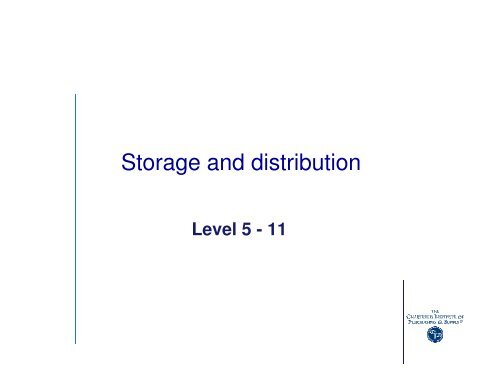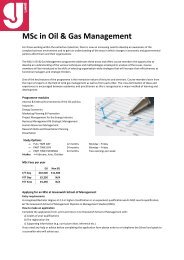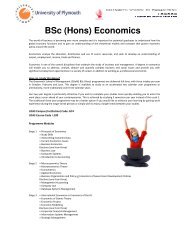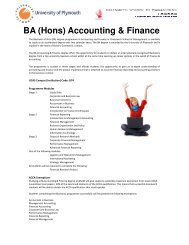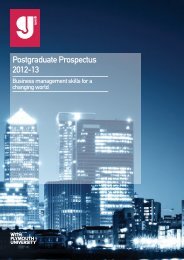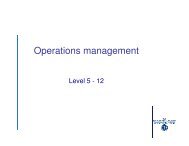L5-11 Storage And Distribution - Greenwich School of Management
L5-11 Storage And Distribution - Greenwich School of Management
L5-11 Storage And Distribution - Greenwich School of Management
You also want an ePaper? Increase the reach of your titles
YUMPU automatically turns print PDFs into web optimized ePapers that Google loves.
<strong>Storage</strong> and distribution<br />
Level 5 - <strong>11</strong>
Session 1<br />
The scope <strong>of</strong> storage and distribution
Learning objectives<br />
At the end <strong>of</strong> this session candidates will be able to:<br />
determine the scope and objectives <strong>of</strong> stores and<br />
distribution<br />
analyse and explain connections between<br />
distribution, storage and the supply chain<br />
develop effective and measurable service<br />
standards<br />
assess and evaluate the concept <strong>of</strong> adding value in<br />
stores and distribution<br />
analyse the problems associated with the area <strong>of</strong><br />
service to cost trade-<strong>of</strong>fs.
Role <strong>of</strong> storage and<br />
distribution<br />
Role <strong>of</strong> storage and distribution in a typical<br />
business environment<br />
Differences between roles the activity has<br />
in different organisations<br />
Network <strong>of</strong> relationships required for the<br />
activity to function effectively
Connections with the supply<br />
chain<br />
Total cost concept and the idea <strong>of</strong> suboptimisation<br />
Total cost concept and why it is relevant<br />
Major areas that need to be evaluated in<br />
order to arrive at an optimal solution<br />
Cross-functional teamworking skills that<br />
need to be developed to avoid suboptimisation<br />
problems
Service standards<br />
Concept <strong>of</strong> the term customer in stores and<br />
distribution environments<br />
Methods that could be used to improve the<br />
internal and external customer interface<br />
Developing appropriate action plans to<br />
improve customer service<br />
Various measures <strong>of</strong> customer performance<br />
internally and externally<br />
Cost <strong>of</strong> service levels versus benefits
Adding value<br />
Adding value in the service context with<br />
appropriate illustration<br />
Role <strong>of</strong> other functions internally and<br />
externally in helping to add value to the<br />
activity<br />
Appropriate measurement criteria in this<br />
area
Added value<br />
Concept is that a product being given<br />
greater value by its supporting processes<br />
that make it more attractive<br />
May be by providing a faster supply chain.<br />
Addition <strong>of</strong> special wrapping to suit<br />
customers requirements<br />
Offering <strong>of</strong> alternative specifications for the<br />
product<br />
Developing new products to suit particular<br />
customer requirements<br />
Offering special promotional deals to<br />
encourage customers to order more<br />
products more <strong>of</strong>ten
Added value<br />
One key point <strong>of</strong> adding value is to<br />
overcome the negative impression that<br />
distribution and logistics function only add<br />
cost<br />
<strong>Distribution</strong> can add value by the process<br />
<strong>of</strong> packaging products attractively also by<br />
breaking bulk<br />
Also specialist companies can provide<br />
added value to distribution
Channel integration<br />
(Dibb, Simkin, Pride & Ferrell 2000)<br />
Vertical<br />
The combination <strong>of</strong> two<br />
or more stages <strong>of</strong> the<br />
channel under one<br />
management<br />
Horizontal<br />
The combination <strong>of</strong><br />
institutions at the<br />
same level <strong>of</strong> channel<br />
operation under one<br />
management
Trade <strong>of</strong>f’s<br />
Within distribution components e.g.<br />
fixed v random storage<br />
Between distribution components –<br />
packaging v storage requirements<br />
Between company functions – optimal<br />
production runs v warehousing costs<br />
Between the company and the external<br />
organisation – direct delivery to store from<br />
manufacturer v delivery to distribution<br />
centre<br />
These type <strong>of</strong> trade-<strong>of</strong>f’s are at the heart <strong>of</strong><br />
the total logistics concept
Problems with service to cost<br />
trade-<strong>of</strong>fs<br />
Major cost and service parameters that<br />
need to be evaluated in the stores and<br />
distribution area<br />
Developing an appropriate method <strong>of</strong><br />
appraising such a problem<br />
Examining environmental factors that could<br />
have an impact in this area<br />
Assessing ways <strong>of</strong> quantifying costs and<br />
service in this area
Service trade-<strong>of</strong>f’s<br />
For example when a customer demands<br />
special deliveries at an inconvenient time<br />
Need to decide if to take on the request or<br />
to refuse the job<br />
Balancing up if it is worth incurring the<br />
extra costs today in return for potential<br />
rewards tomorrow or to save on the cost<br />
today and forego potential future rewards
Objectives <strong>of</strong> storage and<br />
distribution<br />
Definition –<br />
Supply and delivery <strong>of</strong> the right goods, to<br />
the right place at the right time in<br />
accordance with customer requirements<br />
and within an acceptable cost framework<br />
for the supplier
Session 2<br />
<strong>Distribution</strong> planning
Learning objectives<br />
At the end <strong>of</strong> this session candidates will be able to:<br />
evaluation <strong>of</strong> macro-level factors affecting the choice <strong>of</strong> a<br />
storage and distribution network<br />
major methods <strong>of</strong> storage<br />
the concept <strong>of</strong> a distribution network<br />
current methodologies that could be used in this area to<br />
provide an optimal solution<br />
how you would evaluate the use <strong>of</strong> third party contractors<br />
and logistic service providers<br />
develop an appropriate action plan and methodology for<br />
such an exercise<br />
appropriate key performance indicators (KPI’s) in the<br />
selection process<br />
the internal-external interfaces that would need to be<br />
consulted in such an exercise and why<br />
key stakeholders in this area.
Key components <strong>of</strong> logistics<br />
Raw material<br />
Components<br />
Packaging<br />
items<br />
Product<br />
sourcing<br />
Imported<br />
materials<br />
Bought-in<br />
parts<br />
Production<br />
process<br />
Subassembly<br />
Work-inprogress<br />
procurement<br />
Packaging<br />
unitisation<br />
materials management<br />
logistics<br />
Finished Depots<br />
goods<br />
inventory<br />
warehouse<br />
distribution<br />
<strong>Distribution</strong><br />
centres
Factors affecting the choice <strong>of</strong><br />
distribution networks<br />
The nature <strong>of</strong> the distribution business<br />
The products being handled<br />
The markets to be served<br />
This will determine if:<br />
- The distribution network needs to be highly<br />
structured with regular services to major<br />
customers on a frequent basis<br />
- Orders are random and infrequent so that<br />
every weeks delivery plan is different
Factors affecting the choice <strong>of</strong><br />
distribution networks<br />
The markets to be served may be:<br />
Local - for example countrywide<br />
Regional - for example the south east<br />
National - for example whole <strong>of</strong> the country<br />
International - European or global<br />
Knowledge <strong>of</strong> the markets will help to<br />
determine the distribution system. If it is to<br />
be in house or contracted out then other<br />
choices will also need to be made
Factors affecting choice <strong>of</strong><br />
storage and distribution<br />
networks<br />
Customer demands as to when and how<br />
deliveries should be made<br />
Compliance with the law<br />
Financial issues<br />
Health and safety issues
Factors affecting the choice <strong>of</strong><br />
distribution networks<br />
Transport modes:<br />
small items may use a postal or courier<br />
service<br />
road services for local distribution<br />
road or road- rail services for national<br />
distribution<br />
road, road-rail or air services for EU<br />
distribution<br />
air or shipping services for global markets.
Major methods <strong>of</strong> storage<br />
Bulk storage<br />
Loose item storage<br />
Pallet storage systems<br />
Small item storage<br />
Non-standard unit loads
Reasons for using third party<br />
contractors<br />
Traditional arrangements seen to be failing<br />
Contracts take a lot <strong>of</strong> senior management’s<br />
time to coordinate and review<br />
Inability to broaden service <strong>of</strong>fering<br />
Increasing customer service requirements<br />
difficult to maintain<br />
Limited skills in planning<br />
Lack <strong>of</strong> network abilities internationally<br />
Lack <strong>of</strong> IT and change management abilities<br />
Contractors activity rather than value driven<br />
One-<strong>of</strong>f savings made but not long-term cost<br />
reductions
Selection process –<br />
third party providers<br />
Identify service required<br />
Identify potential service providers<br />
Request for information and short list<br />
Prepare invitation to tender and request<br />
for proposal or quotation<br />
Tender evaluation and comparison<br />
Contractor or partner selection<br />
The contract<br />
Implementation plan<br />
Contractor management
Evaluating third party<br />
contractors and suppliers<br />
National/local or regional<br />
Dedicated or exclusive services or multiuser/shared<br />
services<br />
Specialist contractor in particular area <strong>of</strong> goods<br />
Joint venture<br />
Freight only<br />
Depending on:<br />
nature <strong>of</strong> the business<br />
costs<br />
benefits<br />
contractual arrangements<br />
relationships.
KPI’s for third party contractors<br />
Correct treatment <strong>of</strong> customer orders<br />
Deliveries on time<br />
Reporting systems<br />
Monitoring <strong>of</strong> costs and budgets<br />
Feedback <strong>of</strong> statistical information
Session 3<br />
Moving goods
Learning objectives<br />
At the end <strong>of</strong> this session candidates will be able to:<br />
differentiate between the various transport modes in<br />
terms <strong>of</strong><br />
the characteristics and suitability for different consignments<br />
the concept <strong>of</strong> multi-modal transport and its advantages<br />
the factors that need to be considered in vehicle routing<br />
major factors that must be considered in load planning<br />
appropriate computer generated models that could be used to<br />
assist in the areas <strong>of</strong> routing and load planning<br />
how appropriate KPI’s could be developed in this area<br />
the associated problems with UK import control<br />
how the risks can vary with imports depending on the<br />
Incoterm chosen.
Transport modes<br />
Road<br />
Rail<br />
Inland waterways<br />
Coastal, short sea and deep sea<br />
Air<br />
Inter-modal<br />
Pipelines
Factors informing choice<br />
Domestic, Europe-wide, global<br />
Cost<br />
Suitability<br />
Availability<br />
Flexibility<br />
Speed<br />
Reliability<br />
Legislation<br />
Packaging and documentation
Road freight – vehicle choice<br />
Fixed cost <strong>of</strong> vehicle<br />
Variable costs – tyres, maintenance, and<br />
so on<br />
Residual value<br />
Whole life costs<br />
Utilisation costs – miles per gallon, cost per<br />
mile<br />
Ways <strong>of</strong> acquiring – buy, hire, and so on.
Multi-modal transport<br />
Combination <strong>of</strong> different transport modes<br />
(also known as inter-modal)<br />
Offers environmental and operational<br />
benefits<br />
Developing trend because <strong>of</strong> ‘green’<br />
pressures
Vehicle routing<br />
Key considerations include –<br />
Demand data<br />
Distance factors<br />
Customer and service constraints<br />
Vehicle restrictions<br />
Driver constraints<br />
Route factors<br />
Product/unit load constraints
Why use inter-modal transport<br />
Growing awareness that both<br />
environmental and operational objectives<br />
may be best served by using two or more<br />
individual transport modes<br />
This is the case where road operations<br />
have been combined with rail operations<br />
A number <strong>of</strong> logistics operators are now<br />
exploiting the green advantages <strong>of</strong> this<br />
mode
Load planning<br />
Light loads<br />
Heavy loads<br />
Mixed loads<br />
Valuable loads<br />
Liquids and powder in bulk<br />
Hazardous loads
Steps in manual routing<br />
Establish delivery date and parameters<br />
Determine geographic data<br />
Determine demand<br />
Determine customer drop constraints<br />
Allocate demand to geographic area<br />
Decide on geographic rules<br />
Plan trips<br />
Plan routes<br />
Calculate vehicle requirements and mileage<br />
Calculate delivery costs<br />
Calculate vehicle utilisation
Computerised systems<br />
Computer systems for planning and<br />
scheduling – most systems allow both<br />
The essence <strong>of</strong> such systems lies in<br />
achieving the maximum number <strong>of</strong><br />
deliveries within the minimum possible<br />
route mileage and constrained by driver<br />
working hours, receiving times and vehicle<br />
capacity<br />
All based on algorithms and iterations<br />
Often allows for the modelling <strong>of</strong> different<br />
scenarios<br />
Can be far quicker than an manual system<br />
although some companies use a hybrid<br />
system
UK import control<br />
Customs controls<br />
Despatches in the EU<br />
Pre-entry/pre-shipment declaration<br />
Low-value procedure<br />
Simplified clearance procedure<br />
Local export control<br />
Period entry (exports)<br />
Customs entry for non-EU imports<br />
Single administrative documents<br />
T-forms<br />
Carnets
Risks with imports – incoterms<br />
Ex-works – maximum<br />
risk with buyer<br />
FCA<br />
FAS<br />
FOB<br />
CFR<br />
CIF<br />
CPT<br />
CIP<br />
DAF<br />
DES<br />
DEQ<br />
DDU<br />
DDP – maximum risk<br />
with seller
Session 4<br />
Warehousing
Learning objectives<br />
At the end <strong>of</strong> this session candidates will be able to:<br />
appraise the role and effects <strong>of</strong><br />
warehousing and storage <strong>of</strong> goods on the<br />
efficiency and effectiveness <strong>of</strong> the activity<br />
assess the different types <strong>of</strong> warehouses<br />
and equipment available<br />
evaluate different types <strong>of</strong> coding<br />
systems.
Effectiveness and efficiency<br />
Appropriate methodologies for evaluating<br />
the cost and service requirements when<br />
designing the internal layout <strong>of</strong> a stores or<br />
warehouse<br />
Major principles to be evaluated in any<br />
warehouse or stores<br />
The different types <strong>of</strong> design and their<br />
associated advantages or disadvantages<br />
Single and multiple storey buildings and<br />
their cost effectiveness in different<br />
situations
Warehouse and equipment<br />
The different types <strong>of</strong> warehouses and stores to be<br />
found in different organisations:<br />
manufacturing v service<br />
push/pull environments<br />
public versus private sector<br />
the use <strong>of</strong> different types <strong>of</strong> storage and handling<br />
equipment found in a stores and warehousing<br />
environment<br />
methods for increasing the use <strong>of</strong> space in such<br />
areas<br />
how to evaluate cost implications in the use <strong>of</strong><br />
different types <strong>of</strong> storage and handling equipment<br />
the use <strong>of</strong> Pareto analysis and stock-turn with<br />
respect to stock management.
Desirable features <strong>of</strong> a<br />
warehouse<br />
Depend on the throughput <strong>of</strong> materials<br />
Forecasts <strong>of</strong> demand & estimates <strong>of</strong> space<br />
required for aisles and other areas can be<br />
used to calculate basic storage<br />
requirements<br />
Plus need to make provision for other<br />
facilities such as <strong>of</strong>fices, toilets and<br />
canteens<br />
S<strong>of</strong>tware is available to help with designing<br />
warehouses
Desirable features <strong>of</strong> a<br />
warehouse<br />
Absence <strong>of</strong> intrusive pillars, floor joints,<br />
variations in floor levels and excessive<br />
decorative features<br />
Securable windows<br />
Proximity to users or warehouse items<br />
Dry and well ventilated atmosphere<br />
Adequate access to roads and rail connections<br />
also access to seaports and airports if<br />
necessary<br />
Adequate loading & unloading facilities<br />
Durable floor surfaces<br />
Space for expansion<br />
Appropriate planning permission
Desirable features <strong>of</strong> a<br />
warehouse<br />
Dedicated rationalised building design with<br />
maximum potential flexibility for use<br />
Adequate working ceiling height<br />
Space outside the warehouse area for <strong>of</strong>fices<br />
Doors and loading bays which are adequate for<br />
access but capable <strong>of</strong> maintaining security<br />
Adequate and unobtrusive heating equipment<br />
Adequate and where possible natural lighting<br />
Adequate space for broad gangways<br />
Access to water for fire hoses
Desirable features <strong>of</strong> a<br />
warehouse<br />
Acceptable rent and rates<br />
Appropriate compliance with building<br />
regulations<br />
Sound and robust walls<br />
Provision for ancillary services, for<br />
example, public transport and parking
Increasing storage density<br />
Block stacking - loaded pallets placed<br />
directly on the floor and built up in stacks<br />
Adjustable pallet racking (APR) - rigid<br />
racking <strong>of</strong> adjustable height designed for<br />
pallets<br />
Drive in racking - pallet racking designed<br />
to allow access for FLT’s<br />
High rack narrow aisle racking – uses<br />
narrower aisle than APR and special trucks<br />
increases storage density<br />
High bay warehousing – allows pallets to<br />
be stacked up to 30 metres using stacker<br />
cranes
Equipment<br />
Manually operated mechanical handling<br />
equipment<br />
Lift trucks<br />
Reach trucks<br />
Tow trucks<br />
Tractors<br />
Conveyors
Principles <strong>of</strong> stock positioning<br />
Popularity <strong>of</strong> demand – most frequently<br />
requested items are located conveniently<br />
for picking. Could be based on ABC<br />
analysis<br />
Similarity – storing similar goods together<br />
will make it easier to remember where<br />
items are located<br />
Size or weight – large or bulky items may<br />
be kept together<br />
Special characteristics – items with similar<br />
characteristics such as high value or<br />
inflammable can be kept together
Coding systems<br />
The different types <strong>of</strong> coding systems to be<br />
found in a stores environment:<br />
significant<br />
sequential<br />
Self-validating codes<br />
Bar codes<br />
European Article Numbering (EAN)<br />
Interleaved 2 <strong>of</strong> 5<br />
Code 39<br />
UPC
Benefits <strong>of</strong> coding systems<br />
Avoids repeated use <strong>of</strong> long titles<br />
Accurately identifies all items<br />
Prevents duplication <strong>of</strong> items<br />
Assists standardisation and reduction <strong>of</strong> varieties<br />
Provides a foundation for efficient purchasing<br />
Convenient basis for recording and storing<br />
documents<br />
Simplifies mechanical recording<br />
Convenient for central analysis <strong>of</strong> unit storehouse<br />
records<br />
Can be employed as a basis for stock control<br />
accounts<br />
Simplifies pricing and costing<br />
May be used as a storehouse location system
Session 5<br />
<strong>Management</strong> <strong>of</strong> stock
Learning objectives<br />
At the end <strong>of</strong> this session candidates will be able to:<br />
assess the methods used in the<br />
introduction <strong>of</strong> new items and the handling<br />
<strong>of</strong> obsolete and redundant stock<br />
propose methods for handling customer<br />
returns and reverse logistics<br />
evaluate methods for managing unit loads,<br />
pallets, cages and tote boxes.
New and obsolete items<br />
The introduction <strong>of</strong> new items needs to be<br />
managed<br />
Obsolete and redundant stock is likely to<br />
cause difficulties – problems need to be<br />
minimised<br />
Improved communications can reduce<br />
such problems<br />
<strong>Management</strong> information systems can be<br />
used to help control the problems<br />
associated with new introductions,<br />
obsolete and redundant stock
New items<br />
Why are they required?<br />
Will there be a significant demand?<br />
Can the need be satisfied by an existing<br />
product?<br />
If the new item is accepted, will it replace<br />
an existing item?<br />
Can zero inventories be held? (JIT or<br />
vendor managed)
Obsolete items<br />
– maximising residual value<br />
Circulate to other potential users<br />
Negotiate a return price with supplier<br />
Advertise, invite <strong>of</strong>fers<br />
Sell by auction<br />
Sell to a merchant or dealer<br />
Sell to employees<br />
Give to a deserving cause<br />
Recycle<br />
Dismantle for spares
Customer returns<br />
The issue <strong>of</strong> handling customer returns in<br />
different environments<br />
How the problem <strong>of</strong> customer returns<br />
might be examined and improved
Reverse logistics<br />
Relevant when:<br />
Products recalled for quality or safety reasons<br />
Unwanted goods returned<br />
Used packaging for recycling or disposal<br />
Methodology that could be used for<br />
improvements in the area <strong>of</strong> reverse<br />
logistics<br />
KPIs for reverse logistics:<br />
Return rates<br />
Actual costs<br />
Costs less recovered costs<br />
Time
Determining the urgency<br />
For example contamination <strong>of</strong> food<br />
products where time is <strong>of</strong> the essence<br />
If either life threatening or threatening to<br />
the companies reputation then the return<br />
process is obviously urgent<br />
Used packaging or unwanted goods need<br />
to be dealt with efficiently but will not attract<br />
the same level <strong>of</strong> urgency
Establishing where the goods<br />
are in the distribution channels<br />
The more complex the distribution<br />
channels the more costly it will be to<br />
locate and return the goods<br />
A good product traceability system is<br />
essential
Collecting the goods<br />
If the goods are in the hands <strong>of</strong> the<br />
consumer this is the most difficult situation<br />
<strong>of</strong> them all<br />
Need to be able to contact them which is<br />
not always easy<br />
Associated transport costs will be higher<br />
than usual because consignments are<br />
likely to be smaller and more widely<br />
dispersed
Isolating and quarantining<br />
returned goods<br />
This is necessary to avoid the possibility<br />
<strong>of</strong> them being inadvertently being<br />
dispatched again<br />
Especially important where the reason for<br />
collection is not immediately obvious to<br />
the casual observer
Establishing the potential for<br />
salvage and reworking <strong>of</strong> the<br />
products<br />
Where material is moving back up the<br />
distribution channel for recycling the<br />
urgency may be reduced unless it is <strong>of</strong> a<br />
hazardous nature<br />
Important to note that the disposal and<br />
handling <strong>of</strong> all types <strong>of</strong> waste is controlled<br />
by a great deal <strong>of</strong> legislation
Cost <strong>of</strong> returns<br />
Cost elements involved in a product recall<br />
fall under four headings:<br />
Communication<br />
Documentation<br />
Replacement costs<br />
Disposition costs.
Session 6<br />
Stock management
Learning objectives<br />
At the end <strong>of</strong> this session candidates will be able to:<br />
evaluate methods for managing unit loads,<br />
pallets, cages and tote boxes<br />
appraise and evaluate inventory control<br />
systems for independent and dependent<br />
demand
Managing unit loads<br />
Describe the terms: pallets, roll cages, tote<br />
boxes and their uses<br />
The problems associated with the<br />
management <strong>of</strong> these<br />
How improvements in efficiency in these<br />
areas can improve corporate pr<strong>of</strong>itability
Pallets<br />
Most common unit load device (ULD) in<br />
distribution<br />
Basically flat platforms that on which a load<br />
is stacked and then bound or shrink<br />
wrapped against movement or theft<br />
Can be made <strong>of</strong> wood, plastic, metal or<br />
fibreboard<br />
Two common sizes:<br />
Euro pallet 1200mm x 800mm<br />
UK ISO 12,00mm x 1000mm<br />
Also a variety <strong>of</strong> types:<br />
Two way or four way entry<br />
Open or close boarded<br />
Reversible & non reversible
Roll-pallets or roll cages<br />
This ULD has removable metal sizes and<br />
trolley wheels<br />
Size serves as way <strong>of</strong> keeping the goods<br />
secure in transit and for keeping all <strong>of</strong> one<br />
customers goods together<br />
Trolley wheels allow for easy movement<br />
Used extensively in retailing
Advantages<br />
Speed and ease <strong>of</strong> loading on vehicle<br />
Less risk <strong>of</strong> injury due to reduced manual<br />
handling<br />
Can load uniform and non uniform sized<br />
cartons together<br />
Reduces mix ups in consignments<br />
A reduction in the risk <strong>of</strong> pilferage<br />
Can wheel the unit straight to the point <strong>of</strong><br />
delivery
Disadvantages<br />
Cost <strong>of</strong> the units<br />
Repair and replacement costs<br />
Additional weight on the vehicle<br />
Risk <strong>of</strong> loss<br />
Reduced vehicle load capacity<br />
Need to bring empty units back
Tote boxes<br />
Tote (meaning carry) bins are merely small<br />
containers usually stackable and made <strong>of</strong><br />
wood or plastic<br />
Designed for carrying small items and<br />
items <strong>of</strong> low weight<br />
Typically used in retailing operations<br />
Allow small items to be kept together in<br />
transit<br />
Can be locked or sealed to prevent<br />
pilferage <strong>of</strong> individual items
Dependent and independent<br />
demand<br />
When attempting to forecast the demand for apples<br />
the demand for oranges will not have any impact on<br />
the calculation<br />
It is said that the demand for such items is<br />
independent demand<br />
When attempting to forecast the demand for wheels<br />
and tyres, the quantities required will be directly<br />
related to the quantities <strong>of</strong> vehicle bodies that are<br />
being produced<br />
Likewise the number <strong>of</strong> car seats and car doors will<br />
be related to the number <strong>of</strong> vehicles being<br />
manufactured<br />
The demand for motor car components is said to be<br />
dependent demand
Independent demand<br />
Independent demands are usually handled<br />
with stand-alone purchase orders, although<br />
some items might be covered by<br />
contractual relationships including<br />
volume/price and other agreements<br />
Those might use blanket purchase orders<br />
and releases<br />
Simple auto-regressive statistical models<br />
can adequately characterise most <strong>of</strong> the<br />
independent demands encountered
Provisioning for independent<br />
demand items<br />
Independent demand is associated with:<br />
fixed order quantities<br />
continuous and periodic review<br />
continuous and periodic review<br />
systems.
Stock control systems<br />
There are two basic inventory / stock control<br />
systems for independent demand items<br />
1) Periodic (or cyclical) review<br />
2) Re-order point, sometimes described as<br />
‘continuous’ or ‘fixed order quantity
Session 7<br />
Controlling storage and distribution
Learning objectives<br />
At the end <strong>of</strong> this session candidates will be able to identify:<br />
different security measures that could be used in<br />
the area<br />
the effectiveness <strong>of</strong> different systems<br />
methodologies that could be used to improve<br />
efficiency and effectiveness<br />
how improvements between internal and external<br />
customers can reduce security problems<br />
the use <strong>of</strong> different systems established to control<br />
and manage the activity<br />
the need for an integrated computer system<br />
the need for systems that allow management by<br />
objectives and management by exception.
Security risks<br />
Theft from vehicles<br />
Theft <strong>of</strong> vehicles<br />
Dishonest employees<br />
Theft <strong>of</strong> goods<br />
Theft <strong>of</strong> equipment
Theft from distribution vehicles<br />
These are the most attractive targets<br />
Can <strong>of</strong>ten be loaded with high value goods<br />
Need to reduce opportunity <strong>of</strong> theft<br />
Locking doors when left unattended<br />
Not leaving keys in the ignition and the<br />
radio on<br />
Theft also high from vehicle tailboards &<br />
also miscounting can occur
Security methods<br />
Premises:<br />
alarms<br />
fencing and gates<br />
floodlighting<br />
cctv<br />
night patrols<br />
guard dogs.<br />
Vehicles:<br />
alarms<br />
steering column locks<br />
tracking systems.
Staff training<br />
Communicate penalties for dishonesty <strong>of</strong><br />
staff<br />
Train in secure systems for high-value<br />
loads<br />
Train in security awareness<br />
Ensure they do not discuss plans etc.<br />
outside <strong>of</strong> work<br />
Encourage team working for loading /<br />
unloading – for example, watching<br />
tailgates
Security action<br />
Firms need to:<br />
establish tough policies for dealing with<br />
dishonesty amongst staff and theft in particular<br />
establish secure systems for safeguarding high<br />
value loads<br />
build-in security systems to their premises for<br />
example buildings or vehicle parking areas<br />
equip vehicles and trailers with secure locks<br />
and alarm systems.
Security during recruitment<br />
Need to take security right back to staff recruitment<br />
Especially distribution drivers since they are let<br />
loose unsupervised and frequently unmonitored with<br />
vehicles and loads valued at many thousands <strong>of</strong><br />
pounds<br />
Need to check credentials thoroughly<br />
References should be taken up and previous firms<br />
vetted<br />
When high value loads concerned can use a firm<br />
that specialises in security checks<br />
Can also use fidelity guarantee insurance cover –<br />
insures against employees dishonesty
Use <strong>of</strong> security devices<br />
On premises:<br />
High strong, alarmed fencing<br />
Lockable gates<br />
Floodlighting <strong>of</strong> the premises<br />
Manned entrances and exits during working hours<br />
Night patrols and patrol checks<br />
CCTV with manned monitors and video recording –<br />
now static state<br />
Alarm systems – linked to police station<br />
Guard dogs – providing precautions taken.
On vehicles:<br />
Use <strong>of</strong> security devices<br />
Steering column lock<br />
Engine immobiliser<br />
Good cab door and load space locks<br />
Alarms on vehicle and trailer<br />
Kingpin and other types <strong>of</strong> trailer lock<br />
Lockable fuel tanks and fuel flow meter<br />
Tracker systems<br />
Identification painted on ro<strong>of</strong> to allow spotting from<br />
air<br />
Use <strong>of</strong> electronic seals on vehicles and trailers<br />
Keeping keys secure when not in use
Integrated computer systems<br />
Direct product pr<strong>of</strong>itability (DPP) – costs<br />
allocated to specific products so areas <strong>of</strong><br />
inefficiency identified<br />
Materials requirements planning (MRP) –<br />
distribution requirements planning (DRP) –<br />
reduce freight, storage and inventory<br />
holding costs and improve customer<br />
service<br />
Just-in-time (JIT) – eliminates costs and<br />
wastage in production – linked to supply<br />
and demand
Session 8<br />
<strong>Storage</strong> and distribution - performance
Learning objectives<br />
At the end <strong>of</strong> this session candidates will be able to:<br />
major performance criteria<br />
comparative ratios<br />
benchmarking<br />
evaluating chosen criteria with internal and<br />
external customers<br />
defining action plans for improvement<br />
the different roles <strong>of</strong> efficiency and effectiveness<br />
research and modelling in the stores and<br />
distribution area<br />
the appropriate technique in a given situation.
Major performance criteria<br />
Service levels<br />
Utilisation<br />
Performance ratios
Service levels<br />
Standards set – actual achievements<br />
measured against these<br />
Actual costs and other data recorded and<br />
apportioned to cost centres<br />
Actual costs summarised<br />
Actual costs and performance compared<br />
to budget costs and standards set<br />
Any acute deviations identified,<br />
examined and explained<br />
Action taken where necessary
Benchmarking<br />
Objectives Without<br />
benchmarking<br />
Becoming competitive<br />
Industry best practices<br />
Defining customer<br />
requirements<br />
Establishing goals and<br />
objectives<br />
Developing productivity<br />
measures<br />
Internally focused<br />
Evolutionary change<br />
Few solutions<br />
Frantic catch-up activity<br />
Based on history or gut feeling<br />
Perception<br />
Lacking external focus<br />
Reactive<br />
Pursuing pet projects<br />
Strengths and weaknesses not<br />
understood<br />
Route <strong>of</strong> least resistance<br />
With benchmarking<br />
Understanding <strong>of</strong> competition<br />
Ideas from proven practice<br />
Many options<br />
Superior performance<br />
Market reality<br />
Objective evaluation<br />
Credible<br />
Proactive<br />
Solving real problems<br />
Understanding outputs<br />
Based on industry best<br />
practices
Performance monitoring<br />
Proportion <strong>of</strong> items supplied at first demand<br />
Number <strong>of</strong> order-pick errors<br />
Availability <strong>of</strong> back-orders<br />
Proportion <strong>of</strong> orders satisfied in full<br />
Amount <strong>of</strong> damage<br />
Order-to-ship cycle time<br />
Order-to-deliver cycle time<br />
Courtesy <strong>of</strong> staff, ease <strong>of</strong> ordering
Research and modelling in<br />
stores and distribution<br />
Network analyses<br />
<strong>Distribution</strong> modelling<br />
Simulation<br />
Queuing theory
Network analysis process<br />
Often called critical path analysis<br />
The methodology for carrying out a network<br />
analysis is as follows:<br />
List each necessary operation required to<br />
complete a project<br />
Create a diagrammatic representation <strong>of</strong> the<br />
activates using arrows to link events which need<br />
to follow each other<br />
Certain tasks do not need to be carried out<br />
sequentially the diagram can help to visualise<br />
activities that can be carried out simultaneously<br />
It should be now possible to calculate the total<br />
time required for the project (lead time)
Advantages <strong>of</strong> using network<br />
analysis<br />
Allows us to see which activities are dependent on<br />
others being completed on time<br />
The critical path is the line representing the longest<br />
sequence <strong>of</strong> events required to complete a project.<br />
Can find out which activities can be carried out<br />
simultaneously<br />
Allows managers to pay more attention to tasks that<br />
lay on the critical path<br />
Also shows where resources should be<br />
concentrated if you want to shorten the time <strong>of</strong> the<br />
project. Referred to as crashing the network
The modelling or simulation<br />
process<br />
The selection <strong>of</strong> logistics strategy should be driven<br />
by the corporate objectives and the business<br />
strategy<br />
The business strategy will help define priorities in<br />
the spheres <strong>of</strong> product portfolio, customer service<br />
priorities and geographical focus<br />
One the business strategy is established modelling<br />
or simulation can be used to identify optimal<br />
warehousing and distribution strategies<br />
Typically would involve data collection, generating<br />
scenarios and evaluation <strong>of</strong> alternatives
Data collection<br />
Number <strong>of</strong> variables involved in any logistics system<br />
and data collection should ask to obtain quantitative<br />
information as far as possible<br />
Examples:<br />
cost and lead times associated with having<br />
different number <strong>of</strong> warehouses<br />
costs associated with different handling solutions.<br />
estimated throughput using alternative handling<br />
systems<br />
inventory holding costs<br />
customer ordering pr<strong>of</strong>iles<br />
customer service targets.
Queuing theory<br />
Many scenarios where things or people arrive<br />
at unscheduled intervals<br />
Mathematical formulae have been devised to<br />
improve the flow <strong>of</strong> customers at busy times<br />
By estimating the likely number <strong>of</strong> customers<br />
over a period <strong>of</strong> time, the average length <strong>of</strong> time<br />
taken to serve the customers it is possible to<br />
calculate the number <strong>of</strong> servers required to<br />
reduce waiting times<br />
Good example is the supermarket<br />
Can also be used in storage and distribution.
Session 9<br />
Legal aspects
Learning objectives<br />
At the end <strong>of</strong> this session candidates will be able to:<br />
the areas affected by the Health and Safety at Work Act<br />
the roles and responsibilities <strong>of</strong> staff and management in<br />
the working <strong>of</strong> the Act<br />
major roles placed on organisations as a result <strong>of</strong> the Act<br />
the requirements <strong>of</strong> COSHH (Control <strong>of</strong> Substances<br />
Hazardous to Health) in the materials and environments<br />
to which they are applicable<br />
the roles and responsibilities <strong>of</strong> management and staff<br />
under the Act<br />
the role <strong>of</strong> major transport legislation in the control <strong>of</strong><br />
hazardous goods<br />
the role under this legislation for drivers and<br />
organisations involved.
Health and safety<br />
To maintain and improve standards <strong>of</strong><br />
health and safety for people at work<br />
To protect people against risks arising from<br />
work <strong>of</strong> others<br />
To control the storage and use <strong>of</strong><br />
explosives, highly flammable or dangerous<br />
substances<br />
To control the emission into the atmosphere<br />
<strong>of</strong> noxious or <strong>of</strong>fensive fumes from work<br />
premises
Requirements <strong>of</strong> organisations<br />
Draw up health and safety policies<br />
Appoint safety representatives<br />
Establish safety committees<br />
Ensure that workplaces meet all necessary<br />
safety requirements <strong>of</strong> the law<br />
Every employee is also responsible for<br />
their own safety and that <strong>of</strong> others
Specific regulations for<br />
storage and distribution<br />
Carry out risk assessments and record<br />
findings<br />
Maintenance <strong>of</strong> workplaces<br />
Ventilation and temperatures<br />
Lighting<br />
Condition <strong>of</strong> floors and routes for<br />
pedestrians and vehicles<br />
Protection from falling objects and from<br />
persons falling from a height<br />
Manual handling regulations<br />
Personal protective equipment
Control <strong>of</strong> substances<br />
hazardous to health (COSHH)<br />
To protect employees who are exposed to<br />
hazardous substances in the workplace<br />
Carry out risk assessment and put measures in<br />
place to prevent or control identified risks<br />
Monitor employee exposure to hazardous work<br />
processes<br />
Inform, instruct and train employees<br />
Ensure all processes are ongoing and reviewed<br />
regularly<br />
Important when hazardous substances being<br />
transported
Major transport legislation<br />
Goods vehicle licensing<br />
Driver licensing<br />
Goods vehicle excise duty and insurance<br />
Driver’s hours law and tachograph controls<br />
Goods vehicle weights and dimensions<br />
Construction, use and lighting <strong>of</strong> vehicles<br />
Maintenance and annual testing <strong>of</strong> heavy<br />
vehicles<br />
Special load regulations
Good repute<br />
Vehicle operators must be free <strong>of</strong> past<br />
convictions for the following <strong>of</strong>fences:<br />
overloading<br />
use <strong>of</strong> defective vehicles<br />
unauthorised (unlicensed) vehicle use<br />
failure to comply with driver’s hours law and<br />
tachograph recording requirements<br />
goods vehicle plating and annual testing<br />
observance <strong>of</strong> speed limits and other traffic<br />
regulations<br />
forgery and fraudulent use <strong>of</strong> road haulage licences<br />
and permits.
Session 10<br />
New developments and concepts
Learning objectives<br />
At the end <strong>of</strong> this session candidates will be able to:<br />
evaluate the role <strong>of</strong> ICT in storage and<br />
distribution<br />
evaluate major developments in ICT and<br />
their effect on storage and distribution<br />
evaluate the use and impact <strong>of</strong> the internet<br />
on the storage and distribution function<br />
evaluate the use and impact <strong>of</strong> enterprise<br />
resource planning (ERP) and its overall<br />
value to the organisation.
ICT and it’s role and scope<br />
Systems<br />
Electronic data interchange<br />
Enterprise resource planning<br />
Supply chain management<br />
Warehouse management<br />
Forecasting and inventory management<br />
Vehicle fleet management<br />
Computerised routing and scheduling<br />
EPOS
Use <strong>of</strong> computers in basic<br />
stores management<br />
Electronic data interchange (EDI)<br />
Data capture<br />
Bar code scanning<br />
OCR scanning<br />
Voice recognition<br />
Radio data transmission<br />
Inventory control<br />
Traffic information
Role <strong>of</strong> the internet<br />
Home shopping<br />
Small loads<br />
Personalised service<br />
Return <strong>of</strong> perishable goods<br />
Limited time windows<br />
Specialist small vehicles
Role <strong>of</strong> the internet<br />
Business to Business (B2B) – direct<br />
trading<br />
New geographical markets<br />
Downloading overcomes some<br />
infrastructure barriers<br />
Reverse auctions<br />
Direct sourcing <strong>of</strong> raw materials
Use <strong>of</strong> the internet in supplier<br />
selection and relationship<br />
development<br />
Research into potential suppliers using<br />
company sites<br />
Checks with Companies House<br />
Checks with credit agencies<br />
Use <strong>of</strong> extranet to share information
Relevant developments in<br />
technology<br />
EDI<br />
EPOS<br />
Data-capture devices<br />
Voice-recognition systems<br />
Mobile computing<br />
Radio frequency technologies<br />
Truck and trace systems in different<br />
environments<br />
GPS
Enterprise resource planning<br />
(ERP)<br />
S<strong>of</strong>tware that integrates all departments and<br />
functions across a company onto a single computer<br />
system that can serve all those departments’<br />
particular needs<br />
It:<br />
Integrates financial information<br />
Integrates customer order information<br />
Standardises and speeds up manufacturing processes<br />
Reduces inventory<br />
Standardises HR information


